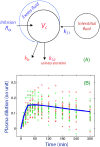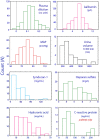Fluid volume kinetics of 20% albumin
- PMID: 30756411
- PMCID: PMC6533427
- DOI: 10.1111/bcp.13897
Fluid volume kinetics of 20% albumin
Abstract
Aims: A population kinetic model was developed for the body fluid shifts occurring when 20% albumin is given by intravenous infusion. The aim was to study whether its efficacy to expand the plasma volume is impaired after major surgery.
Methods: An intravenous infusion of 3 mL/kg 20% albumin over 30 minutes was given to 15 volunteers and to 15 patients on the 1st day after major open abdominal surgery. Blood samples and urine were collected during 5 hours. Mixed-effect modelling software was used to develop a fluid volume kinetic model, using blood haemoglobin and urine excretion the estimate body fluid shifts, to which individual-specific covariates were added in sequence.
Results: The rise in plasma albumin expanded the plasma volume in excess of the infused volume by relocating noncirculating fluid (rate constant k21 ), but it also increased losses of fluid from the kinetic system (kb ). The balance between k21 and kb maintained the rise in plasma albumin and plasma volume at a virtual steady-state for almost 2 hours. The rate constant for urinary excretion (k10 ) was slightly reduced by the preceding surgery, by a marked rise in plasma albumin, and by a high preinfusion urinary concentration of creatinine. The arterial pressure, body weight, and plasma concentrations of C-reactive protein and shedding products of the endothelial glycocalyx layer (syndecan-1, heparan sulfate, and hyaluronic acid) did not serve as statistically significant covariates.
Conclusions: There were no clinically relevant differences in the kinetics of 20% albumin between postoperative patients and volunteers.
Keywords: albumin; fluid kinetics; heparan sulfate; hyperoncotic; syndecan-1.
© 2019 The British Pharmacological Society.
Conflict of interest statement
There are no competing interests to declare.
Figures






Similar articles
-
The importance of albumin infusion rate for plasma volume expansion following major abdominal surgery - AIR: study protocol for a randomised controlled trial.Trials. 2016 Dec 7;17(1):578. doi: 10.1186/s13063-016-1714-5. Trials. 2016. PMID: 27923389 Free PMC article. Clinical Trial.
-
Elevated Plasma Concentrations of Syndecan-1 Do Not Correlate With Increased Capillary Leakage of 20% Albumin.Anesth Analg. 2021 Mar 1;132(3):856-865. doi: 10.1213/ANE.0000000000005315. Anesth Analg. 2021. PMID: 33350618 Clinical Trial.
-
Recruitment of extravascular fluid by hyperoncotic albumin.Acta Anaesthesiol Scand. 2018 Oct;62(9):1255-1260. doi: 10.1111/aas.13150. Epub 2018 May 29. Acta Anaesthesiol Scand. 2018. PMID: 29845612
-
[Indications and role of albumin for vascular loading during postoperative intensive care].Ann Fr Anesth Reanim. 1996;15(4):497-506. doi: 10.1016/0750-7658(96)83212-6. Ann Fr Anesth Reanim. 1996. PMID: 8881490 Review. French.
-
The use of volume kinetics to optimize fluid therapy.J Trauma. 2003 May;54(5 Suppl):S155-8. doi: 10.1097/01.TA.0000064515.51896.DE. J Trauma. 2003. PMID: 12768119 Review. No abstract available.
Cited by
-
Kinetics of 5% and 20% albumin: A controlled crossover trial in volunteers.Acta Anaesthesiol Scand. 2022 Aug;66(7):847-858. doi: 10.1111/aas.14074. Epub 2022 May 13. Acta Anaesthesiol Scand. 2022. PMID: 35491239 Free PMC article. Clinical Trial.
-
The Effect of Albumin Administration in Critically Ill Patients: A Retrospective Single-Center Analysis.Crit Care Med. 2024 May 1;52(5):e234-e244. doi: 10.1097/CCM.0000000000006218. Epub 2024 Feb 7. Crit Care Med. 2024. PMID: 38502807 Free PMC article.
-
Temporal Decline in Intravascular Albumin Mass and Its Association with Fluid Balance and Mortality in Sepsis: A Prospective Observational Study.J Clin Med. 2025 Jul 24;14(15):5255. doi: 10.3390/jcm14155255. J Clin Med. 2025. PMID: 40806877 Free PMC article.
-
Albumin as a drug: its biological effects beyond volume expansion.Crit Care Resusc. 2020 Sep;22(3):257-265. doi: 10.1016/S1441-2772(23)00394-0. Crit Care Resusc. 2020. PMID: 32900333 Free PMC article. Review.
-
Dehydration before Major Urological Surgery and the Perioperative Pattern of Plasma Creatinine: A Prospective Cohort Series.J Clin Med. 2021 Dec 13;10(24):5817. doi: 10.3390/jcm10245817. J Clin Med. 2021. PMID: 34945113 Free PMC article.
References
-
- Caironi P, Tognoni G, Masson S, et al. Albumin replacement in patients with severe sepsis or septic shock. New Engl J Med. 2014;370(15):1412‐1421. - PubMed
-
- Faraq E, Ebrahim Z. The perioperative use of albumin In: Faraq E, ed. Kurz, editors: Perioperative fluid management. Cham, Switzerland: Springer; 2016:215‐234.
-
- Hahn RG. Arterial pressure and the elimination of crystalloid fluid: a population‐based study. Anesth Analg. 2017;124(6):1824‐1833. - PubMed
-
- Hahn RG, Drobin D, Zdolsek J. Distribution of crystalloid fluid changes with the rate of infusion: a population‐based study. Acta Anaesthesiol Scand. 2016;60(5):569‐578. - PubMed
Publication types
MeSH terms
Substances
LinkOut - more resources
Full Text Sources
Research Materials

